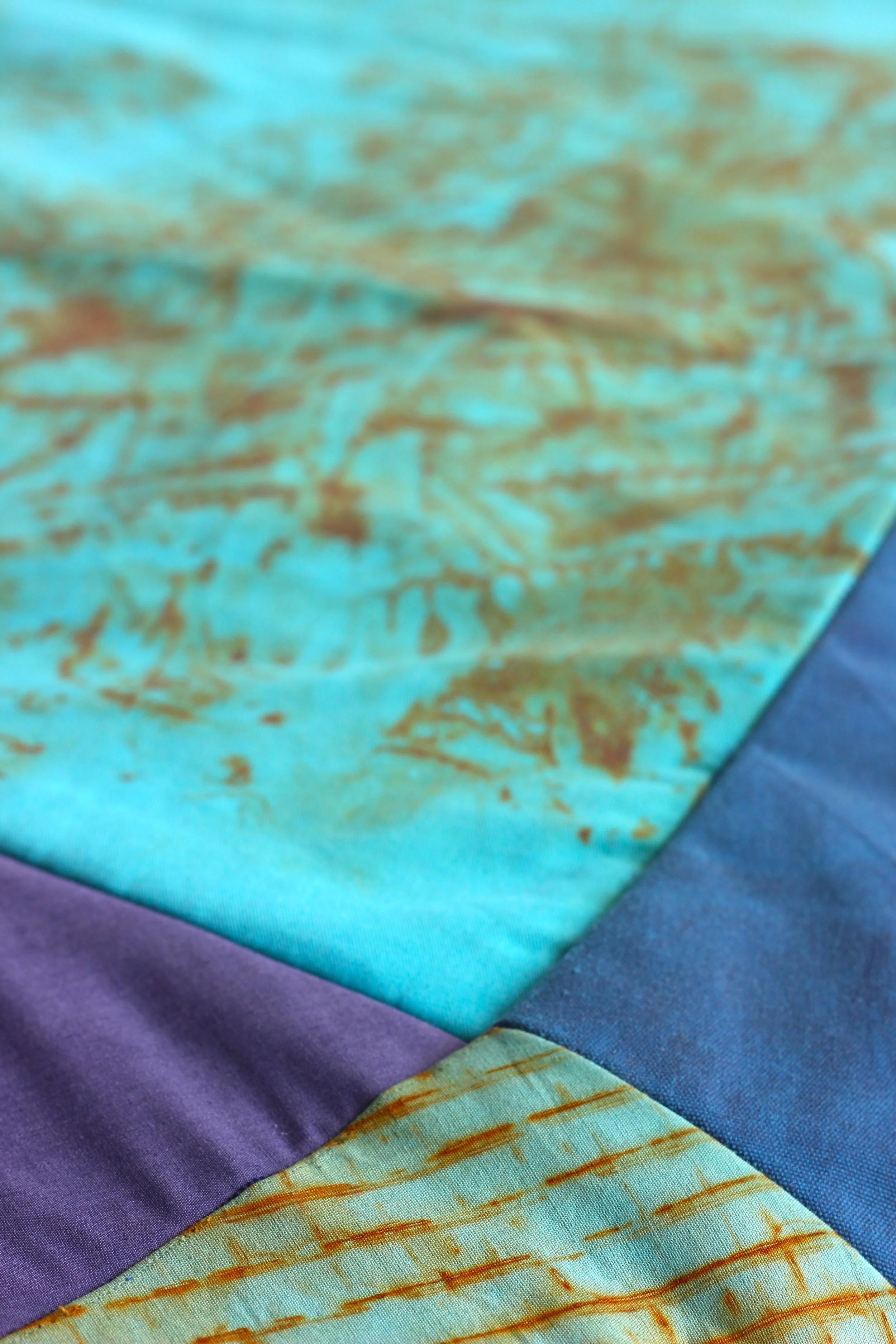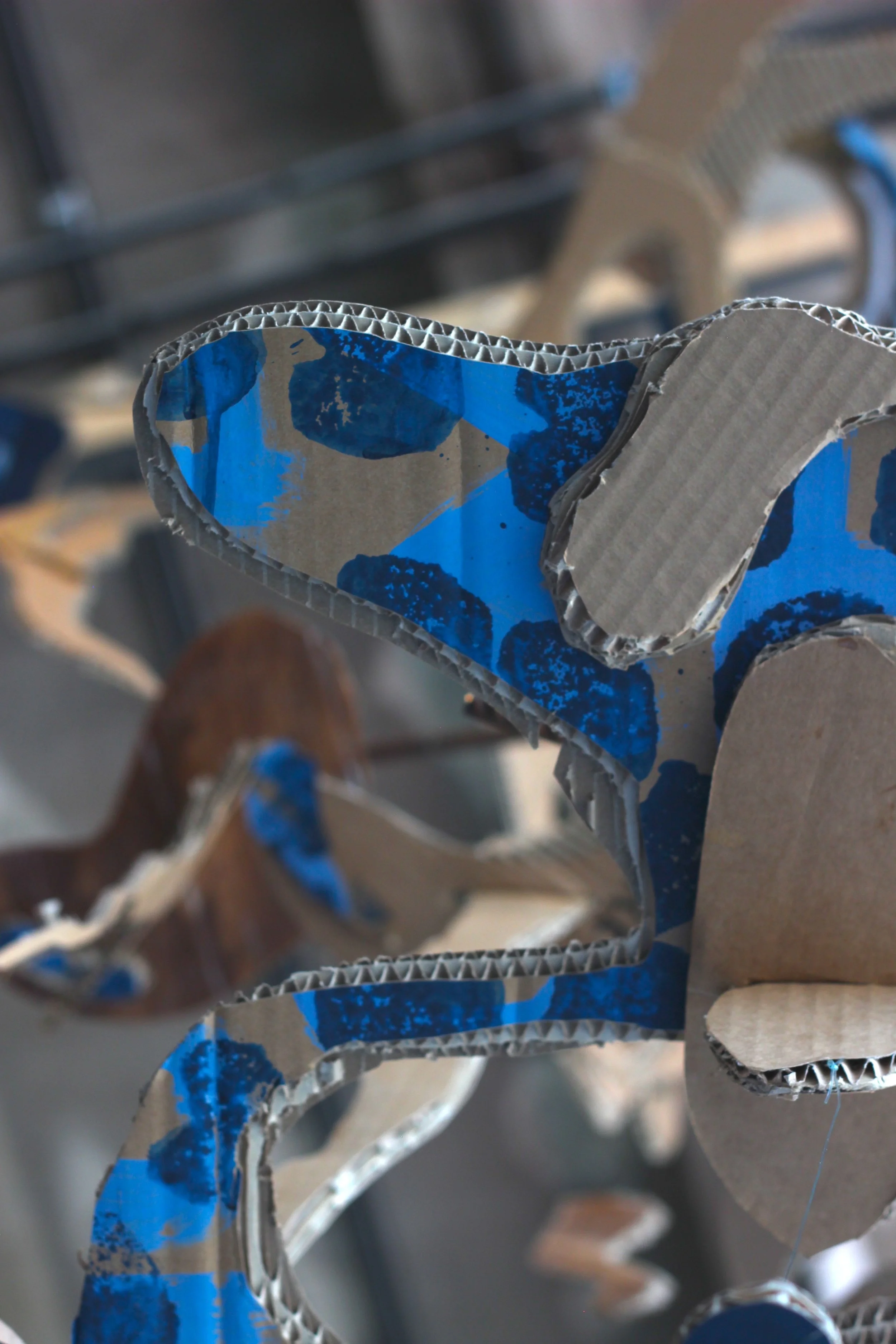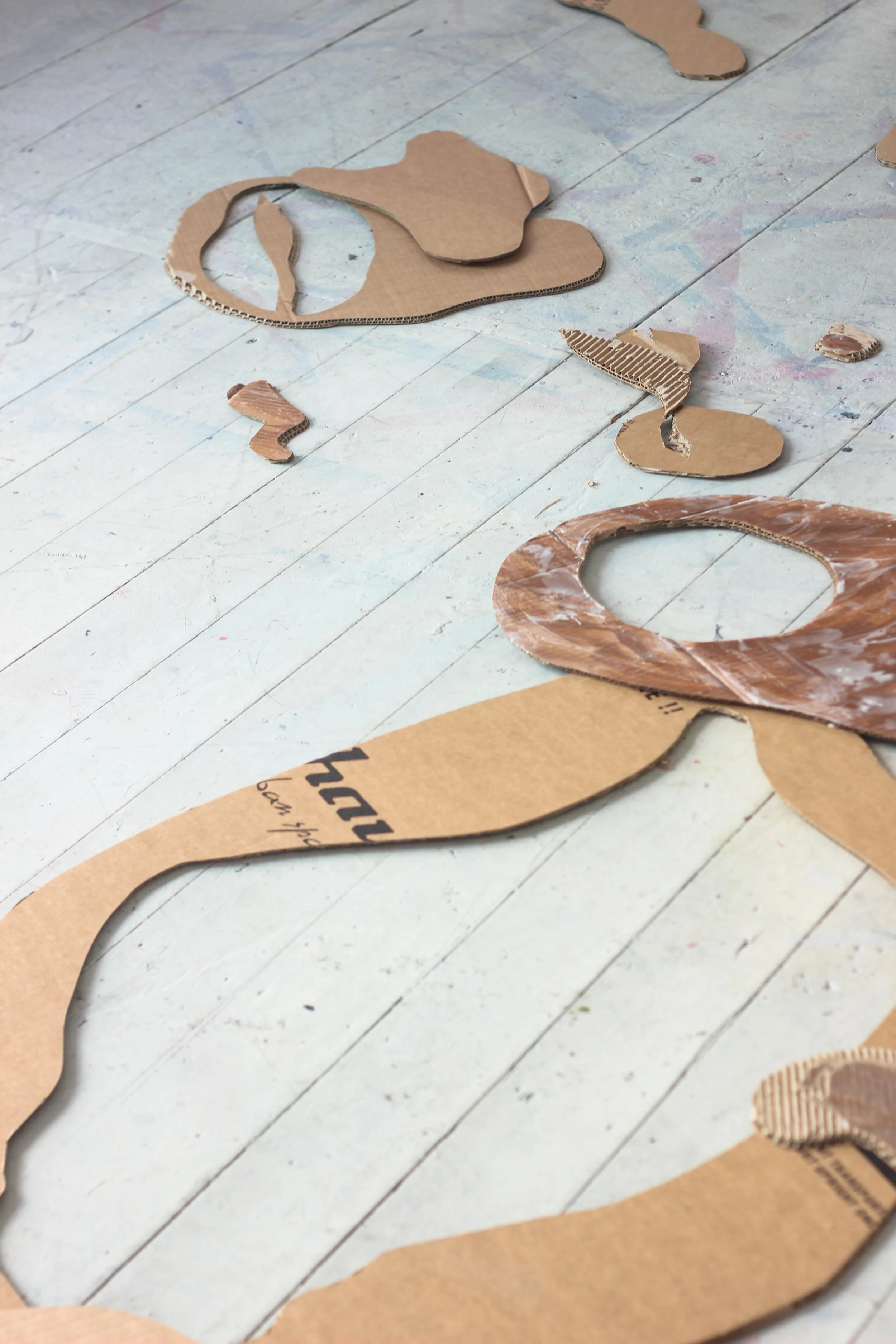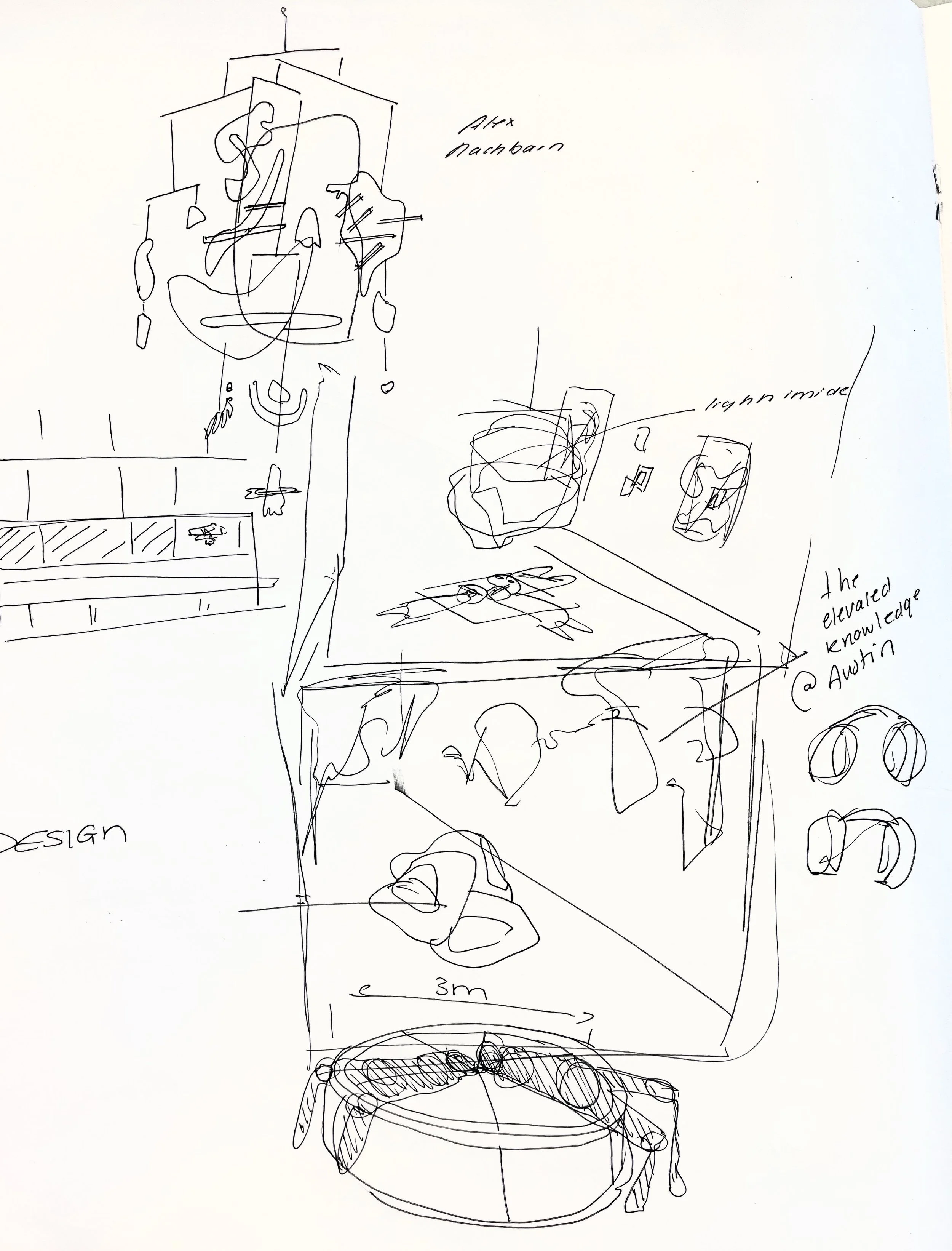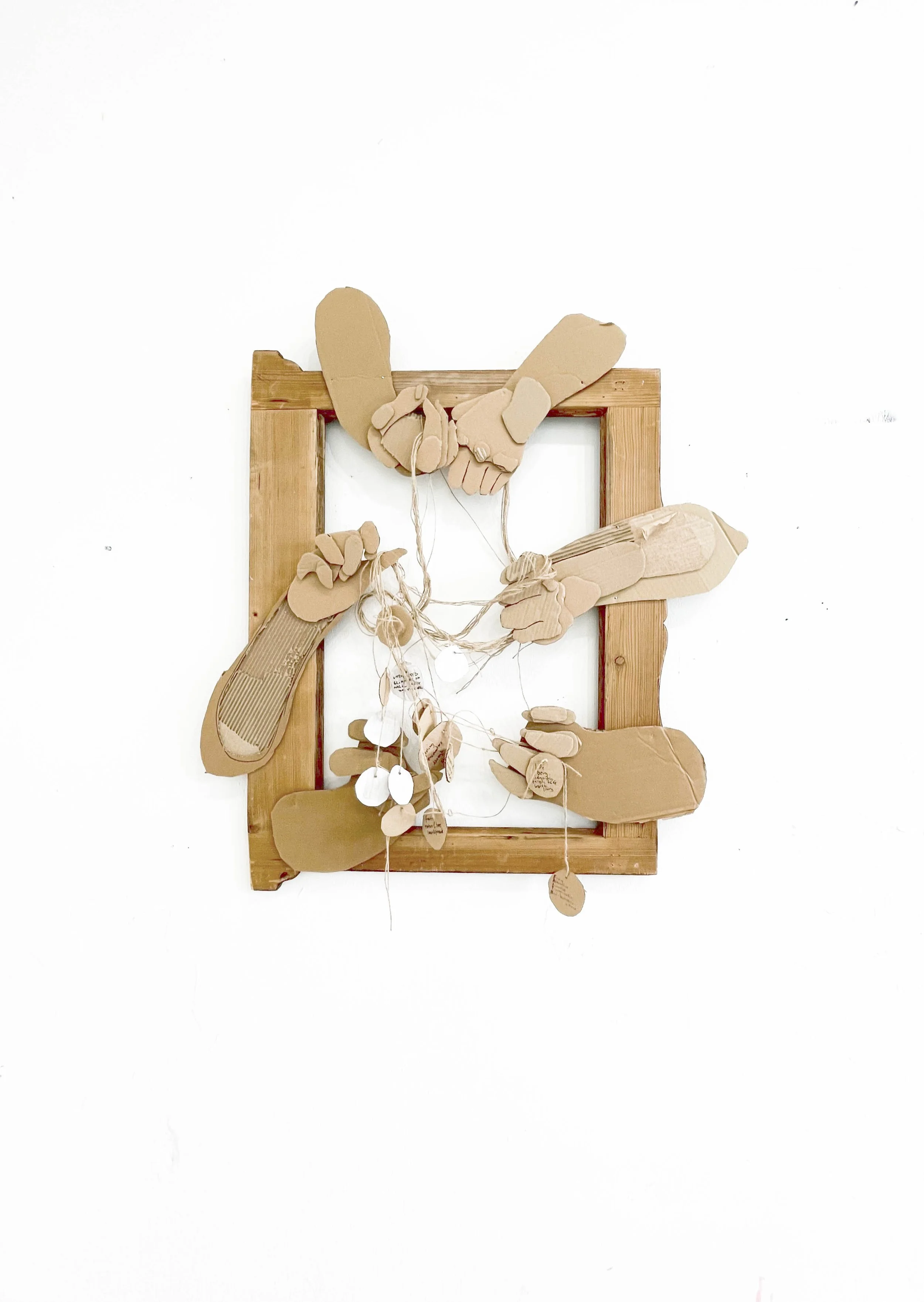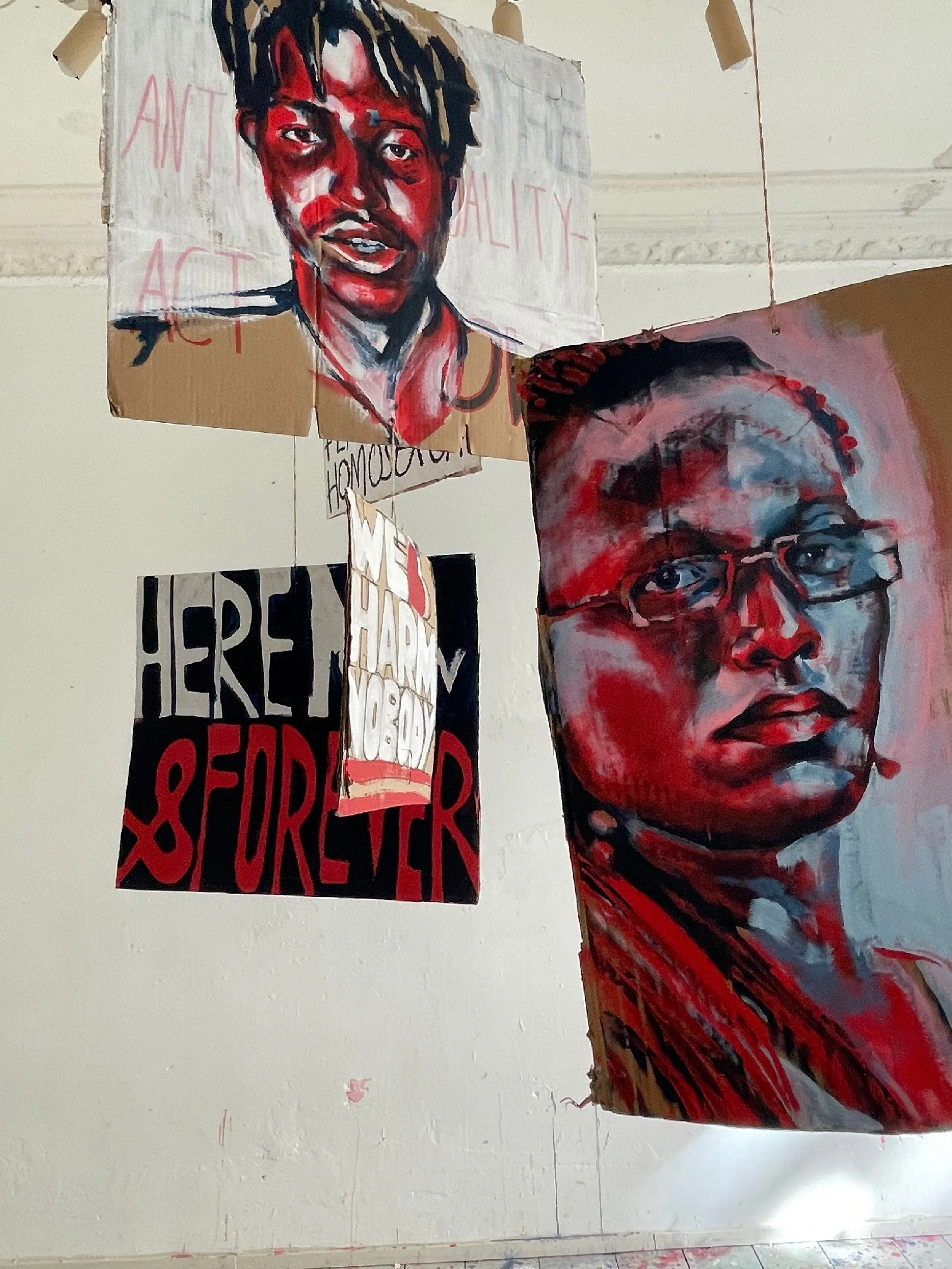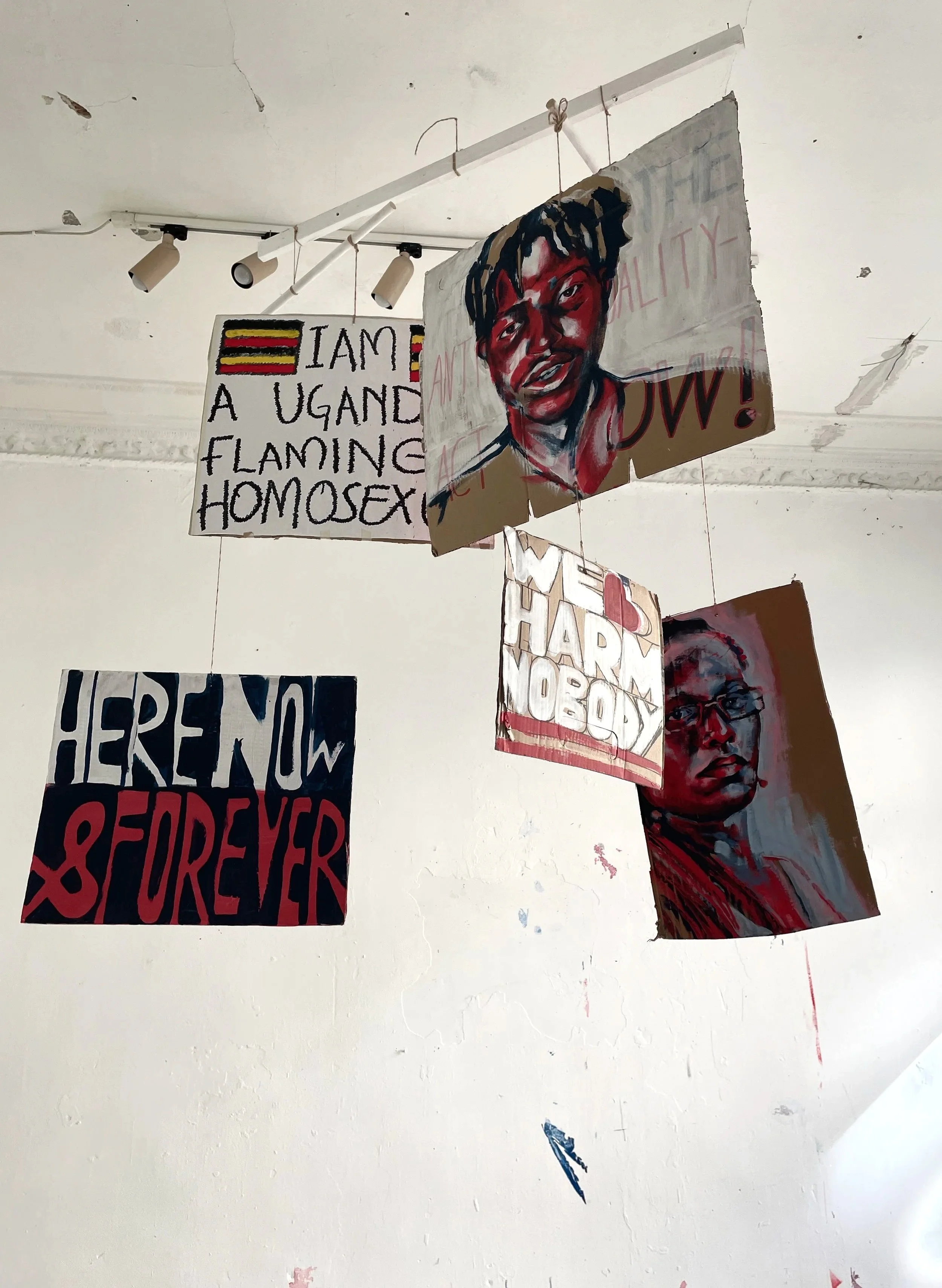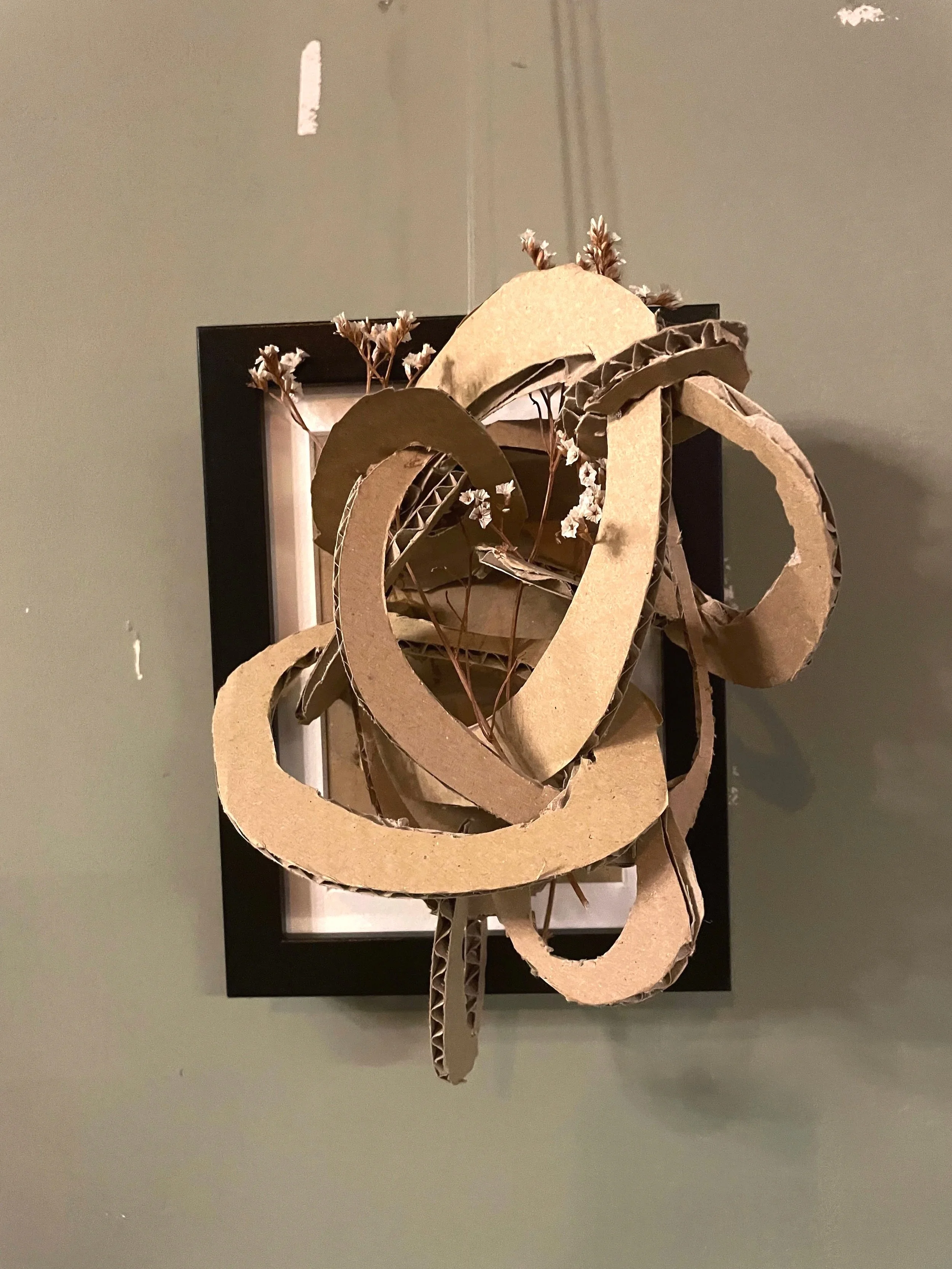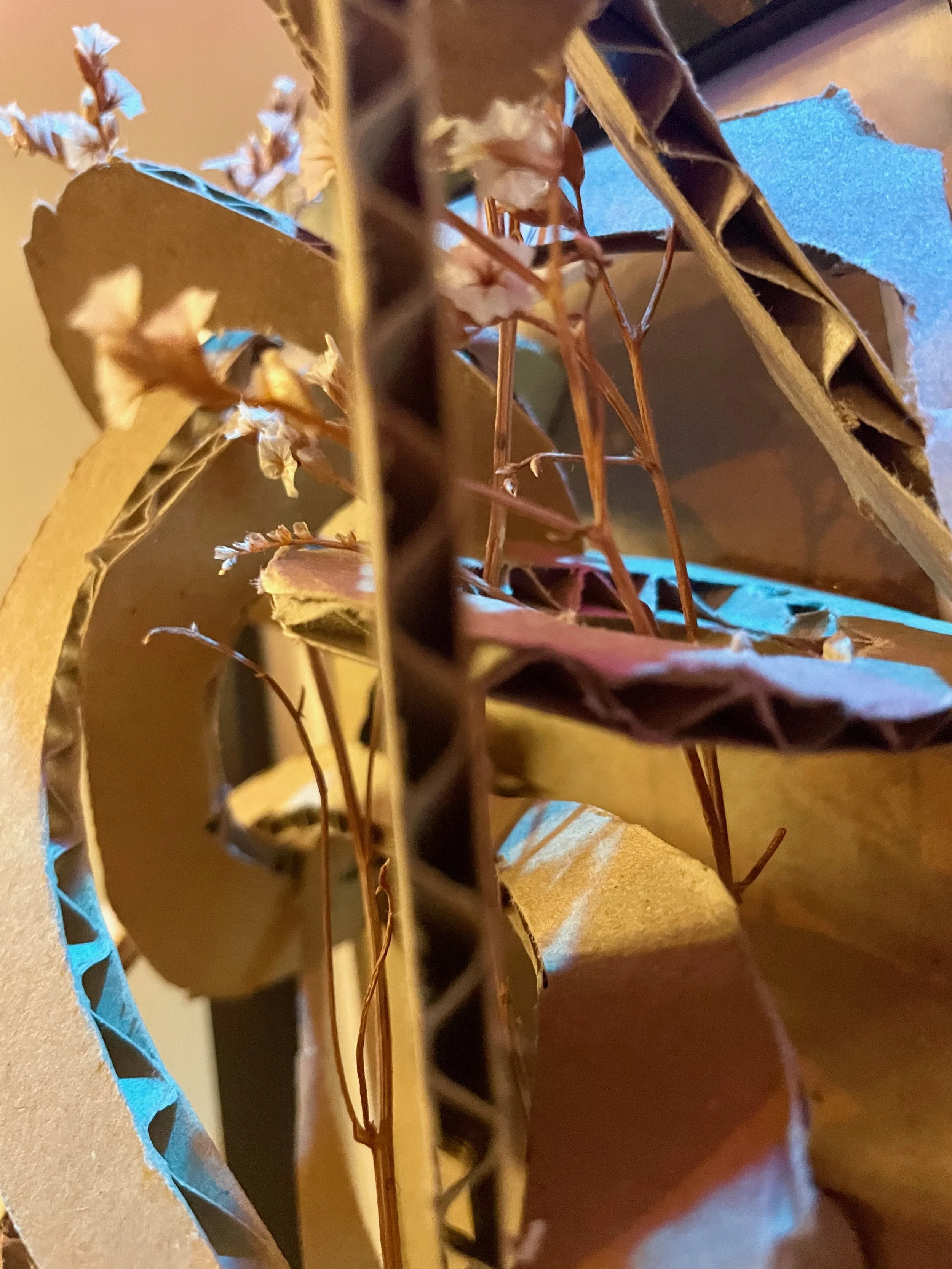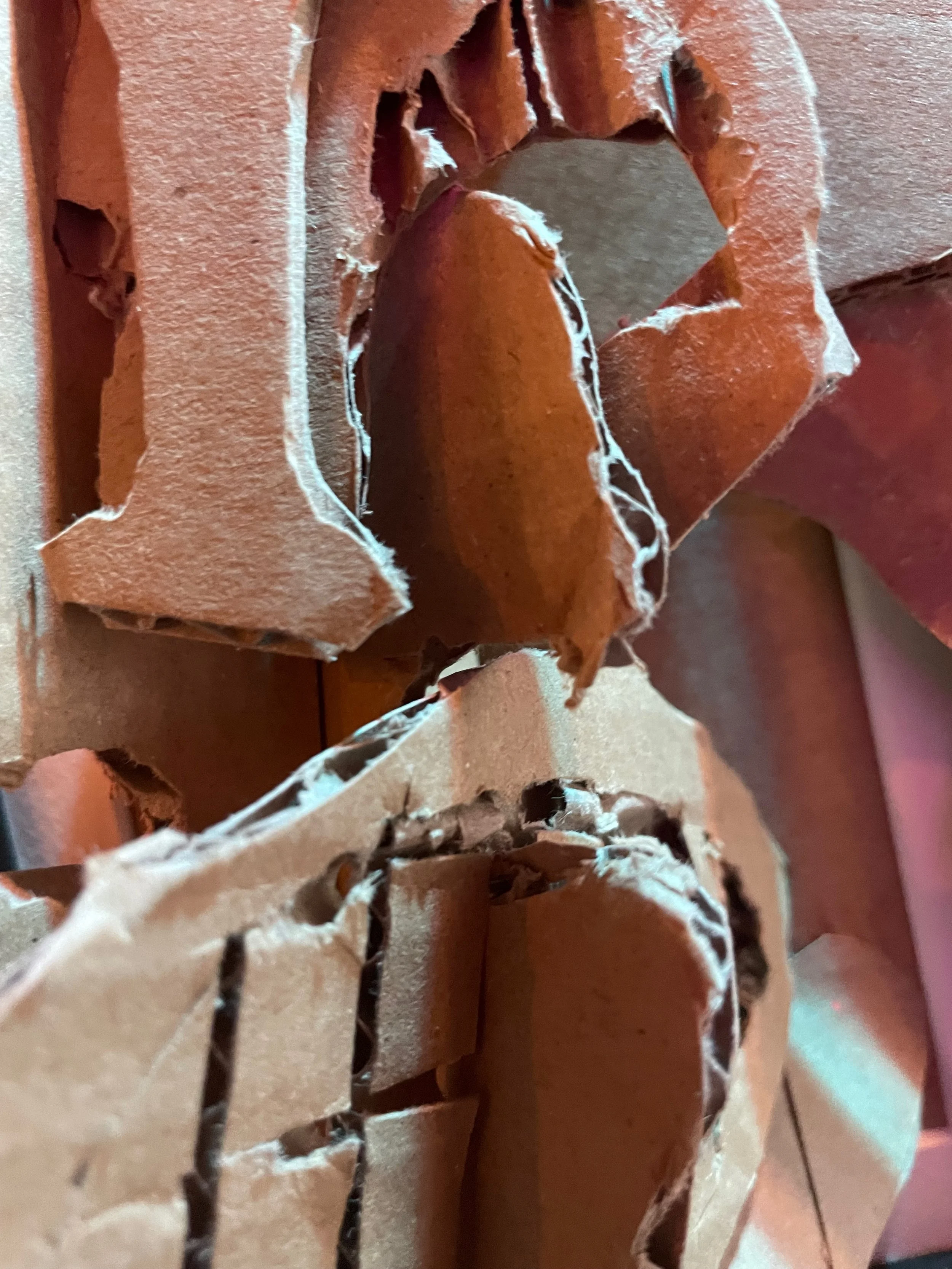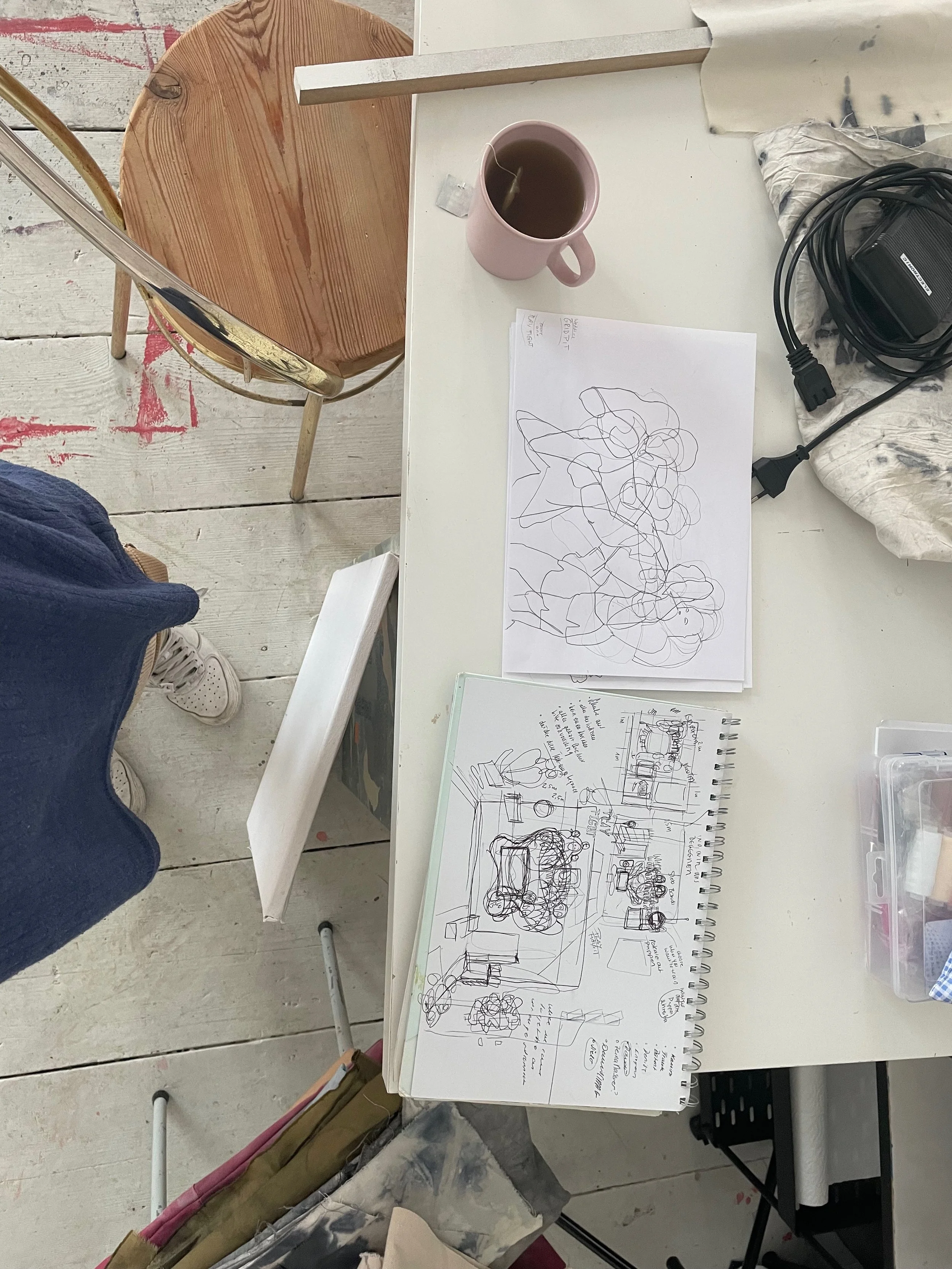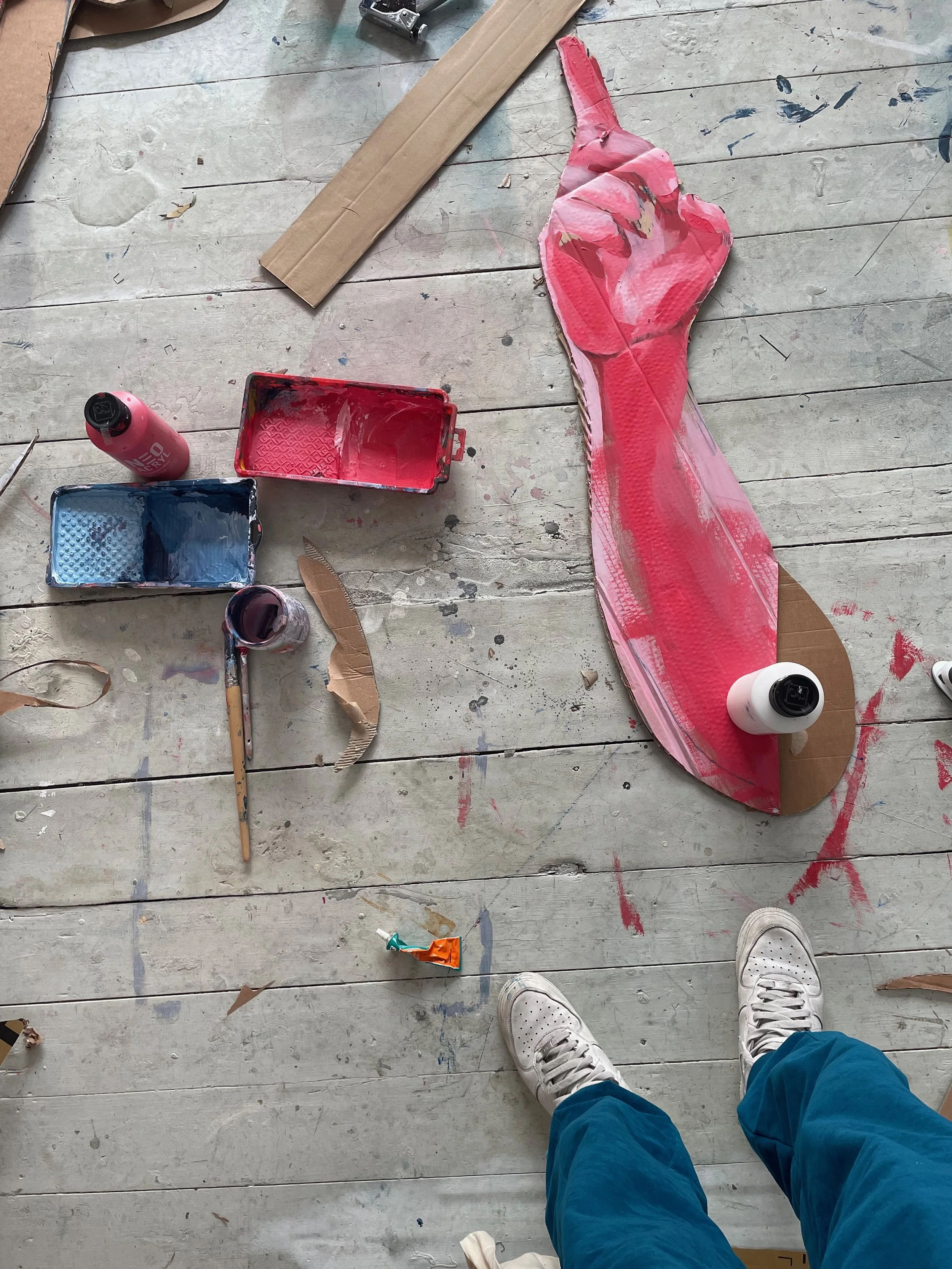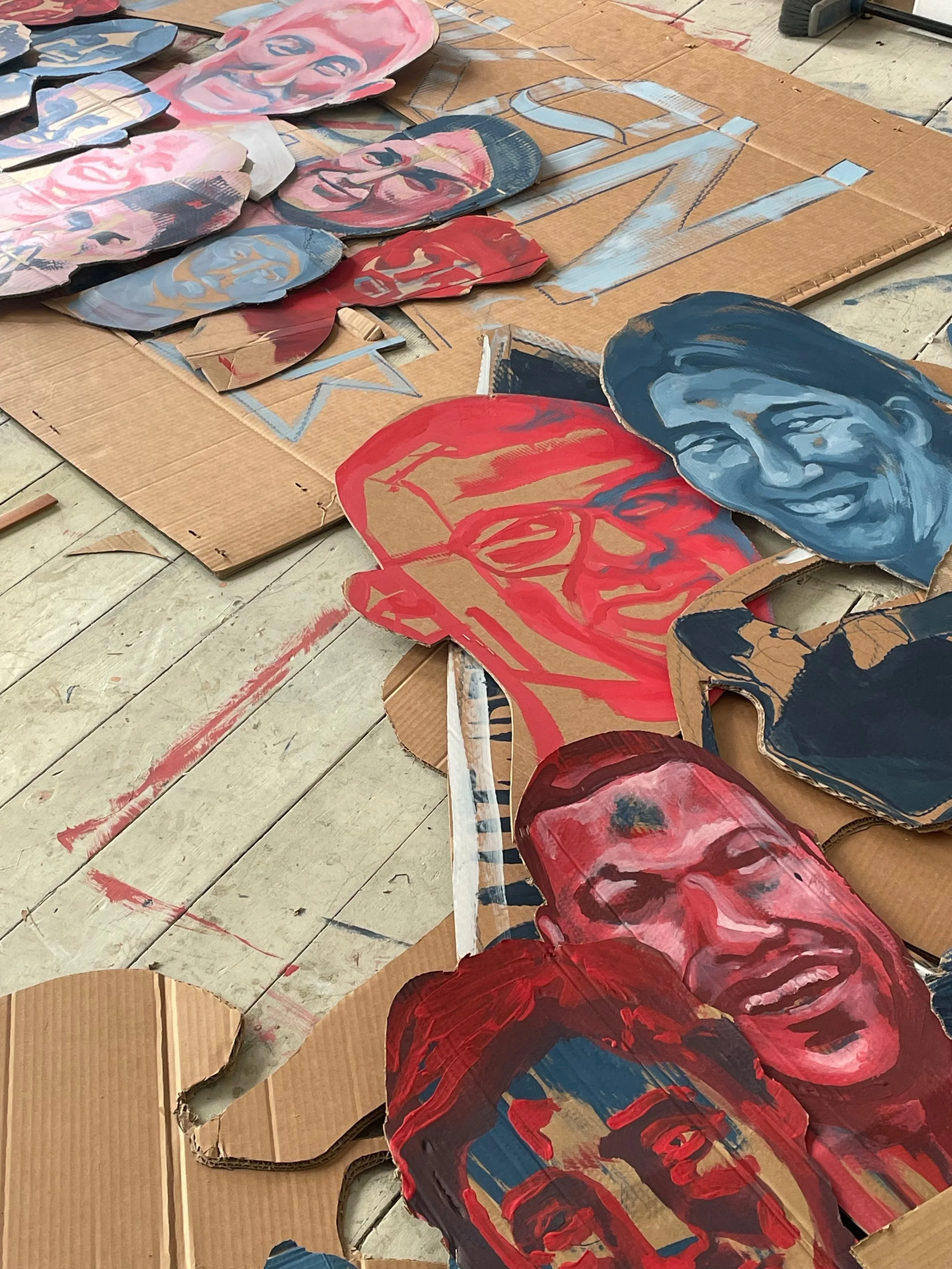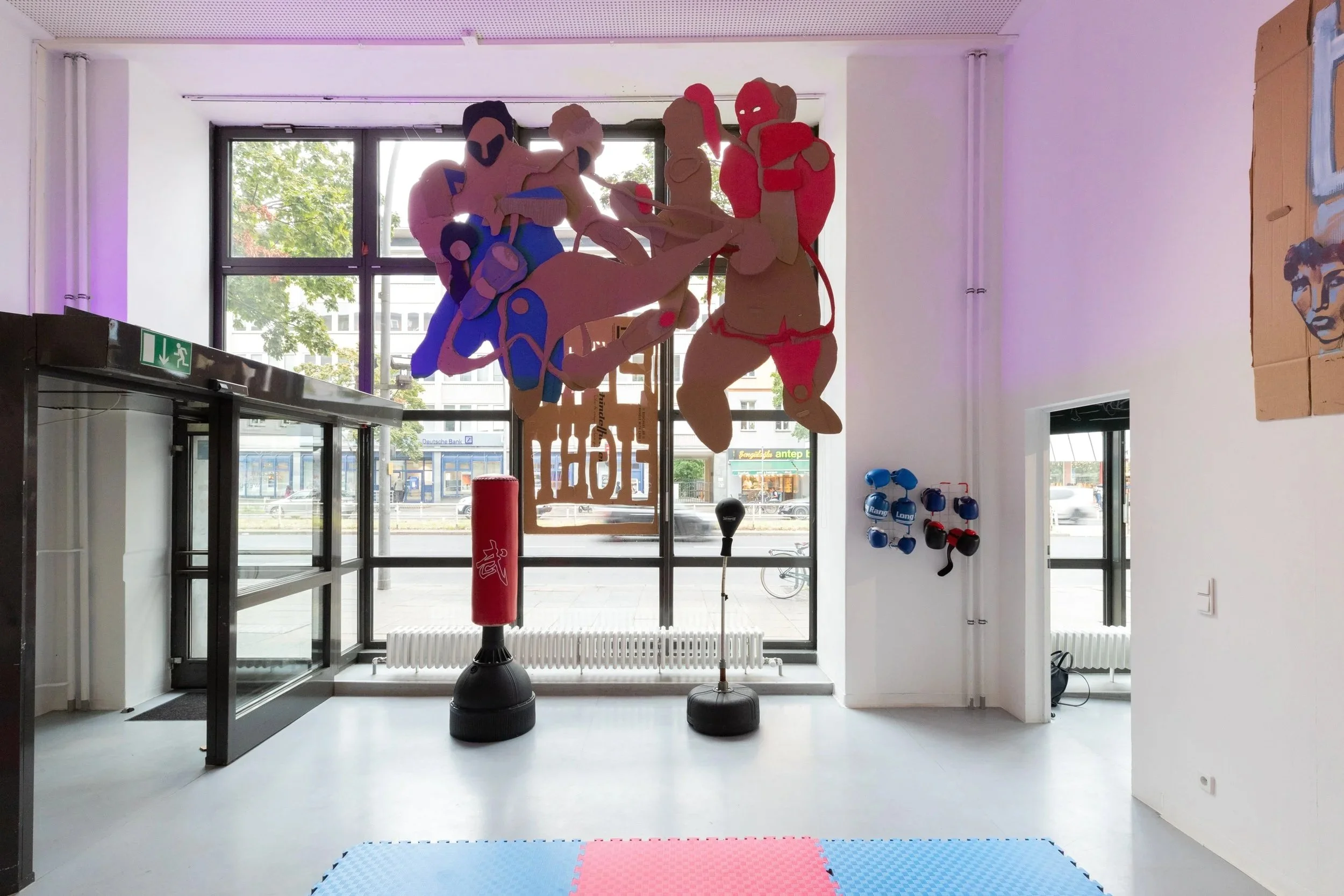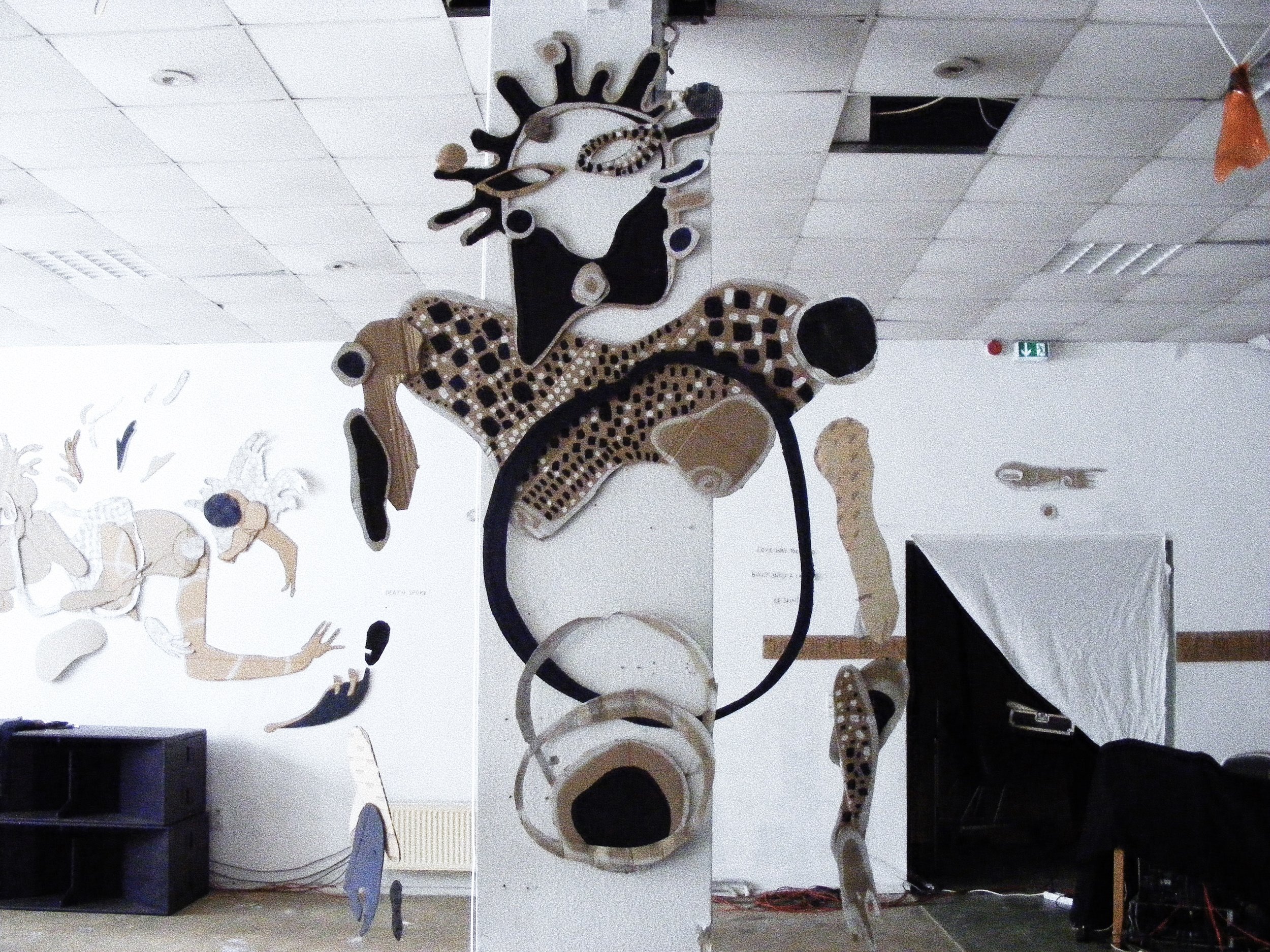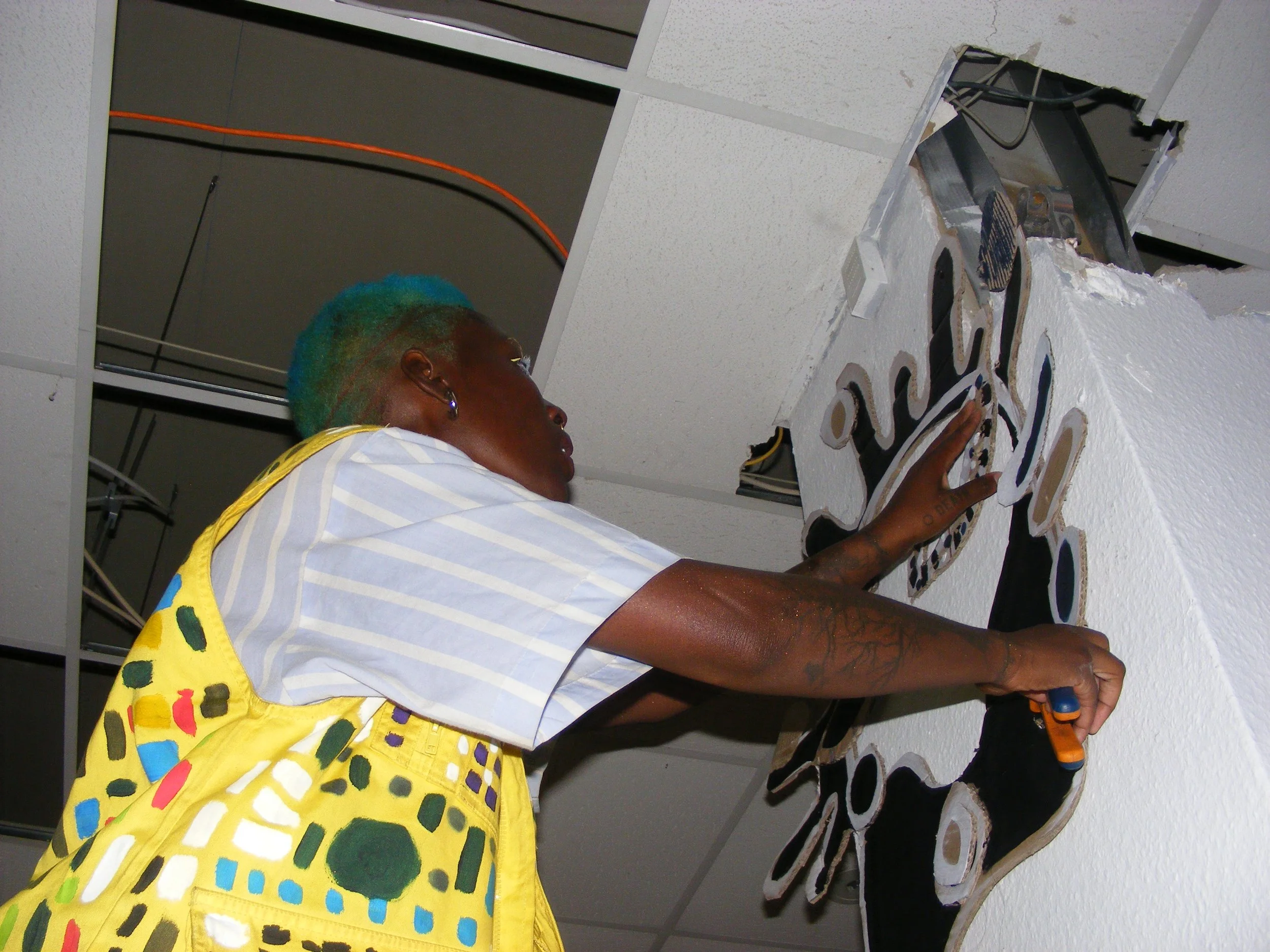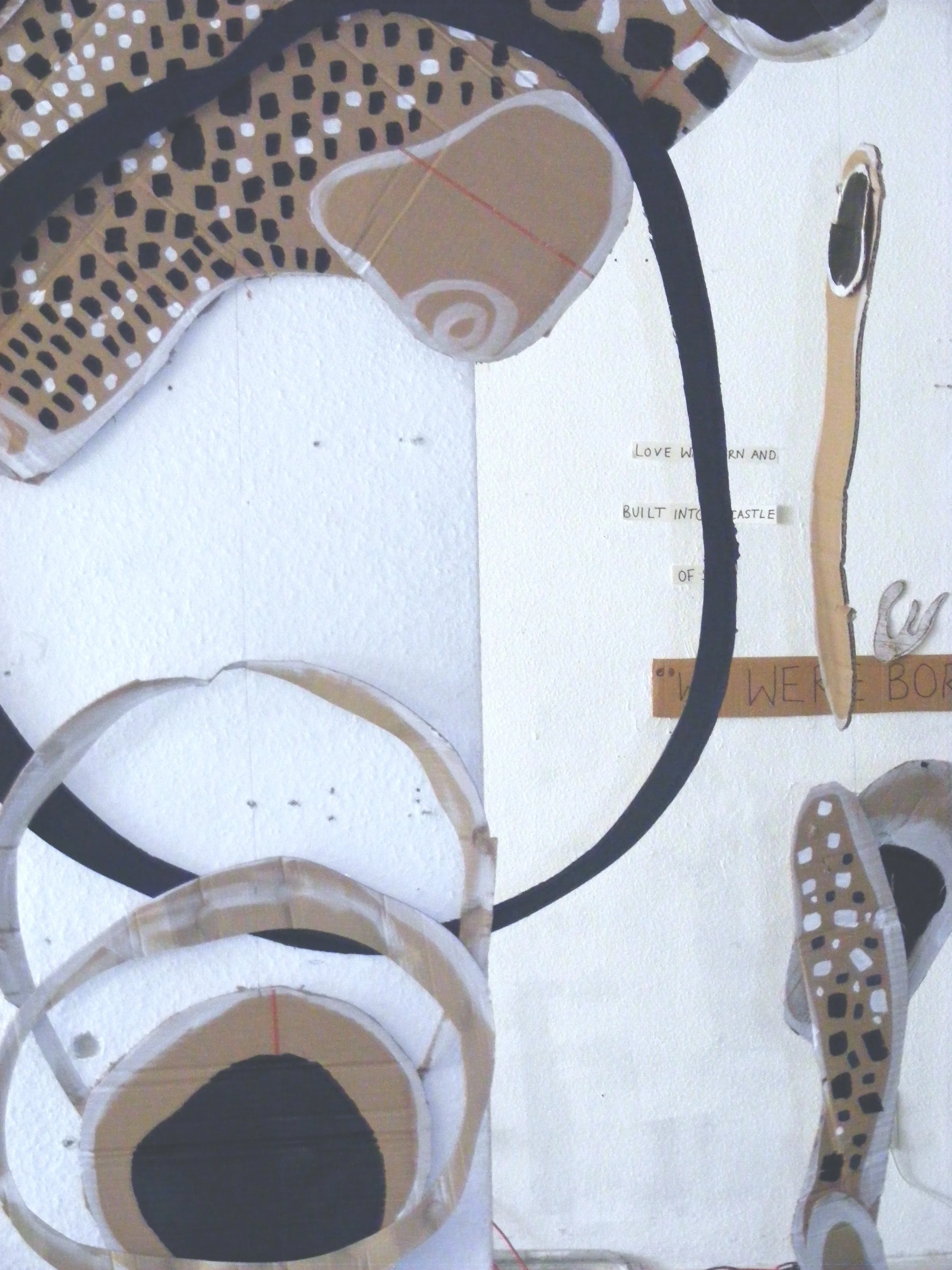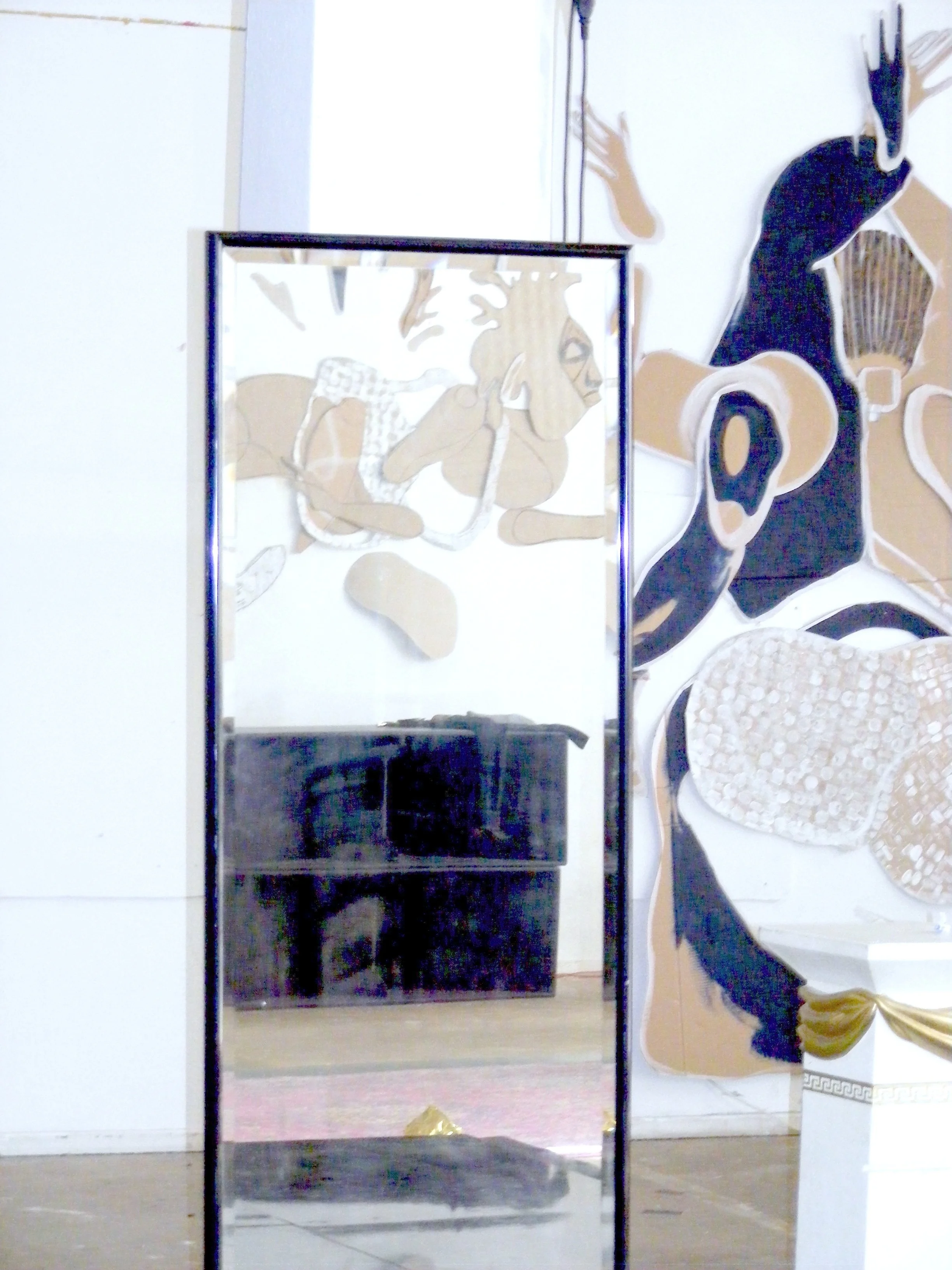PORTFOLIO
// Cardboard Sculptures
Defining
Survival
Queer Everexistence in Motion | 2025

“Defining Survival (Queer Everexistence in Motion)” is a cardboard, textile and sound installation and the first institutional collaboration of Bodi Babatola, Austin Nortey and Chie Marquart-Tabel
In this interdisciplinary collaborative project, Chie’s cardboard sculptures and semifigurative visual language fusioned with Austin’s scrap metal and textile work: Chie incorporated scrap metal that Austin had brought from Kumasi into the mobile, while both together wax-dyed the quilt to make Chie’s seed-like forms part of the textile without losing Austin’s rust-patterns.
The process was shaped by questions, tries and discoveries and led to a work that combines the visual language of both artists, while giving a home to the audio recording of Bodi Babatola that can be listened to while laying on the quilt.
Bodi Babatolas poem was written at the studio next to the quilt- and mobile making and speaks to the shared idea of a queer, resistant force we hold within us.
Defining Survival (Queer Ever- existence in Motion) considers queer survival as connection across places and times, as leaving traces and spores, as becoming part of a cycle. Through the combination of Austin Nortey's work with second hand textiles and metal scraps that speaks of the connection of material, time and change, and Chie Marquart- Tabel's semi-figurative, mystical formal language that runs through cardboard sculptures and quilt, the artists create a space of connection and care.
By inviting viewers to lie on the quilt, watch the movements of the sculptures and follow the poetic sound installation “Seedling Library” by Bodi Babatola, the group show Choreographies of Care ends here with a place that invites you to pause, arrive and rest.
To listen to the poem and look into the mobile click here.
Quilt | Detail from Defining Survival
a collaboration of Austin Nortey and Chie Marquart-Tabel, 2025
Mobile | Detail from Defining Survival
a collaboration of Austin Nortey and Chie Marquart-Tabel, 2025
Process Documentation
draft for the quilt
Defining Survival (Queer Everexistence in Motion) Cardboard, Scrap Metal, Textile
500cm x 500cm x 500cm
2025
What do you hold on to?
Cardboard, Cord and Wood 60cm x 80cm
2024
Which connection are you missing?
Cardboard, Cord and Wood
60cm x 80cm
2024
They
didn’t
know
Queer Everexistence in Motion | 2024
“They didn’t know” was the first chapter in the ongoing project Queer Everexistence in Motion that looks at queer resistence across time and space.
Each work is related to a question on community and resistance that was shared with members of queer communities in Accra and Berlin and incorporates the answers received in various ways.
The mobile, the first mobile Chie created, is made of protest signs that had been used at a protest few weeks prior to the opening.
"They didn't know - Queer Everexistence in Motion" is a solo exhibition by Chie Marquart-Tabel that connects members of queer communities across national borders in 6 interactive sculptures, drawing a line between queer life and liberation struggles then and now. Who of us has which opportunities to fight?
In the face of spreading anti-queer laws in Ghana, Uganda, Kenya, the UK and the USA as well as a worldwide rise in fascism, this ongoing project takes a look at the existence and resistance of queer identities over time.
Intertemporality and interconnectedness as a concept weave threads from the negated historical existence of African queerness via the revolts of queer elders to the question of how communities and the roles of individuals can become the foundation of queer futures. We have always been there, and we will always be there.
We live in what our ancestors fought for us. What are we creating?
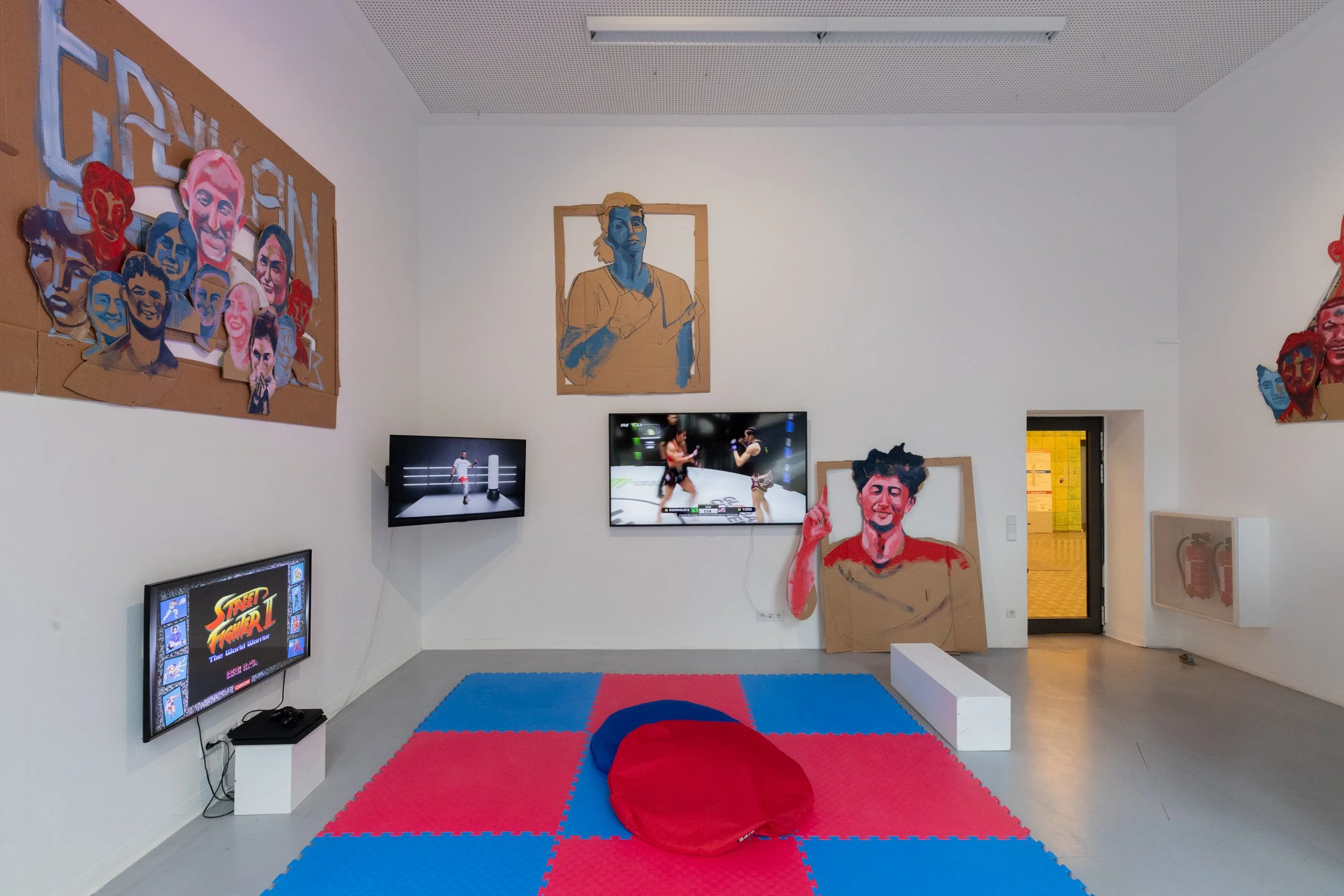
Wedding
Play Fight
an interactive installation exhibition view
2024
Wedding
Play Fight
Roundhall | Galerie Wedding
We meet again on the mat. How do we encounter each other in such a place of extreme experiences, present in our bodies, when we have left some of our insignia of status and belonging in the changing room? When we react to each other, train each other, encourage and challenge each other? On the mat, I am in playful interaction with people with whom I could not or would not otherwise connect. The mutual attempts, successes and failures are obvious, honest and vulnerable. Twice, I met a Security at Lidl that I had trained with before. Those were the only times in my life that I knew the security guards personally. In sport in general and in martial arts in particular, people meet who would not otherwise meet. Not only do we meet, we can also do something with each other, build connections.
Wedding Play Fight is a neighbourhood arena. A place where you can learn to box, let off steam and just be.
The walls display martial arts clubs from the area, Berlin Wedding, with their trainers and fighters in the form of cardboard figures, somewhere between paintings and sculptures. People who train just a few streets away from the exhibition venue watch over you as you try out your first boxing moves on the small mat in the middle of the room, watch a fight or wrestle with your friends.
The basic idea was to create an interactive space. Galerie Wedding is a municipal gallery, financed by taxpayers' money, located directly on Leopoldplatz. Sometimes it made me angry that what is shown here appeals to so few of the people who pass by every day. Not because it wasn't good, but because it wasn't relevant to them. What holds Wedding together is also a question of what might interest the people outside the window. And what reduces the barriers that prevent them from entering.
They'll be knocking down your door.
At the exhibition opening, a young man suddenly stands next to me and asks what we're doing here. I take him to be Arab, which makes him one of two people at this exhibition opening; person number one is my best friend's boyfriend, who is also standing with us. I tell him about the opportunity to box here and that the people on the walls are fighters from the area. He tells me that he trains at Roter Stern, the left-wing Wedding sports club that only costs £10 a month. He likes what we do, says goodbye with a handshake and the words, ‘They'll knock down your doors.’
And in fact, over the next few weeks, the exhibition space becomes a hangout for local teenagers. Visitor numbers to the gallery double for the duration of the exhibition, and the average age is halved. Boys between the ages of ten and fourteen come in groups and spend an hour wrestling on the mat, working the punching bags and lounging in the beanbags. Every now and then, I give training sessions and teach the basics: how to keep your guard up, how to do a roundhouse kick. Kick after kick after kick, they slam their legs into the kicking pad I hold for them.
These children seem to have boundless energy, and I wonder where they have been expressing it until now. One day, I meet 13 kids at once in the slowly cramped room. When I ask them what they have all come for, they reply: it's cold outside and martial arts clubs are too expensive. Which families can afford to spend €60 to €100 per month and child just on sports? The enthusiasm with which people enter this room shows how much it was needed.
Once, I am showing someone around my work when a boy enters the room with his friends. He is Black and light-skinned like me, looks at me, points into the room and says, ‘Cool, huh?’ I grin: ‘I did that.’ ‘No way!’ His eyes are wide, I am proud.
It's not just the kids from the neighbourhood who come to training. On Sundays, I give my weekly training session for queers, now in our own halls instead of outside on the basketball court, under the watchful eyes of Aischa, Denise, Bülent and Frank. Our own little arena, to the sounds of Nadia Rose, Todrick Hall and Cardi B coming from the loudspeakers. Here I hear from many who no longer train because they no longer felt comfortable in the established martial arts clubs. Because they get strange looks in the changing rooms. Who are they telling that to? I myself haven't trained in six months.
I lead the warm-up, going through the basics: how to stand, are you stable? Guard up, now move in a straight line from your guard to your opponent's face and back to your guard. Nice. In pairs, we practise punch combinations and variations of light sparring, stretch and say goodbye to the night in Wedding. My words at check-out are always the same: I was stressed at first, but now I feel calm.
– Chie Marquart-Tabel on “Wedding Play Fight”
Wedding Play Fight
detail
100cm x 80cm
2024
SONIC MIRAGE
Sculptural Set Design on Black Fugitivity
For the performance collective Everything Changes, an installation of these 3 cardboard sculptures was created to frame the show “Sonic Mirage”.
All sculptures were first developed as drawings, then enlarged and brought into into 3-dimensions by tracing line by line out of cardboard.
The pattern on the figure Protect (in the front) is a collaboration with Painter and poet Day-Eve Komet who also wrote the poem that is written on the walls as part of the installation.
Poetry by Day Eve Komet
Photography by Marb (@marbsworld)
Protect
Cardboard, Acrylic
150cm × 110cm
2023
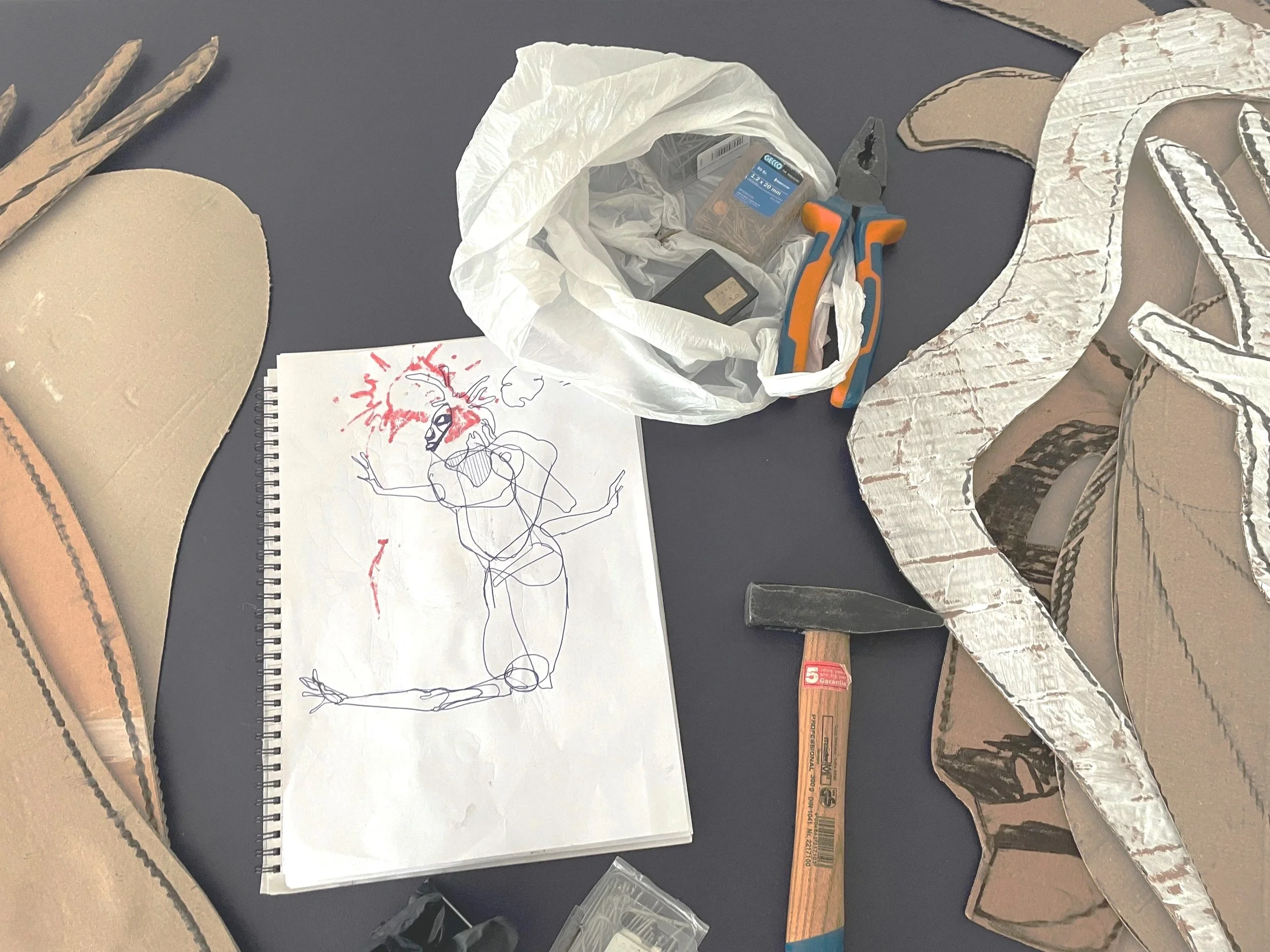
Death Spoke
Cardboard, Acrylic
200cm × 200cm
2023
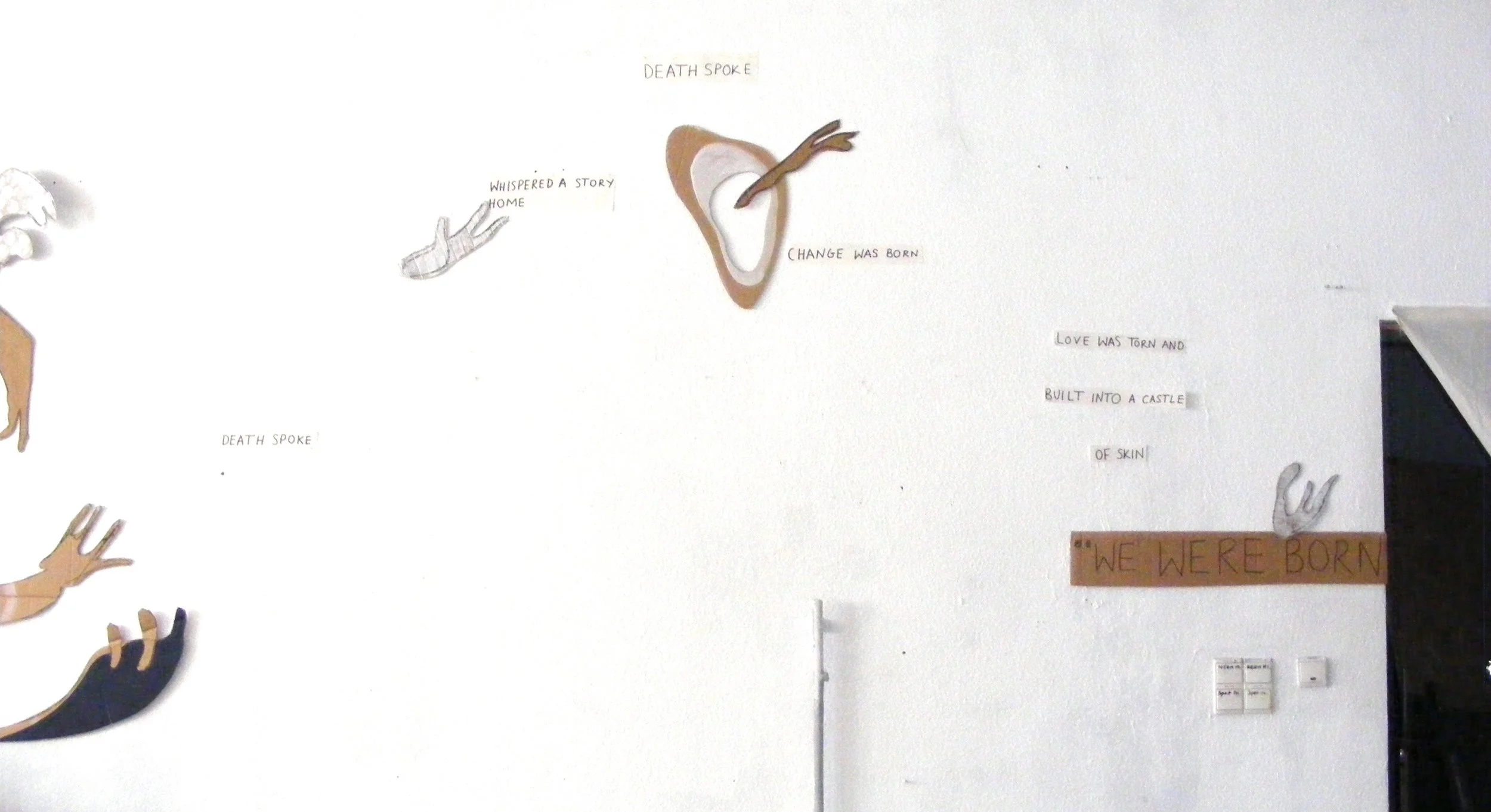
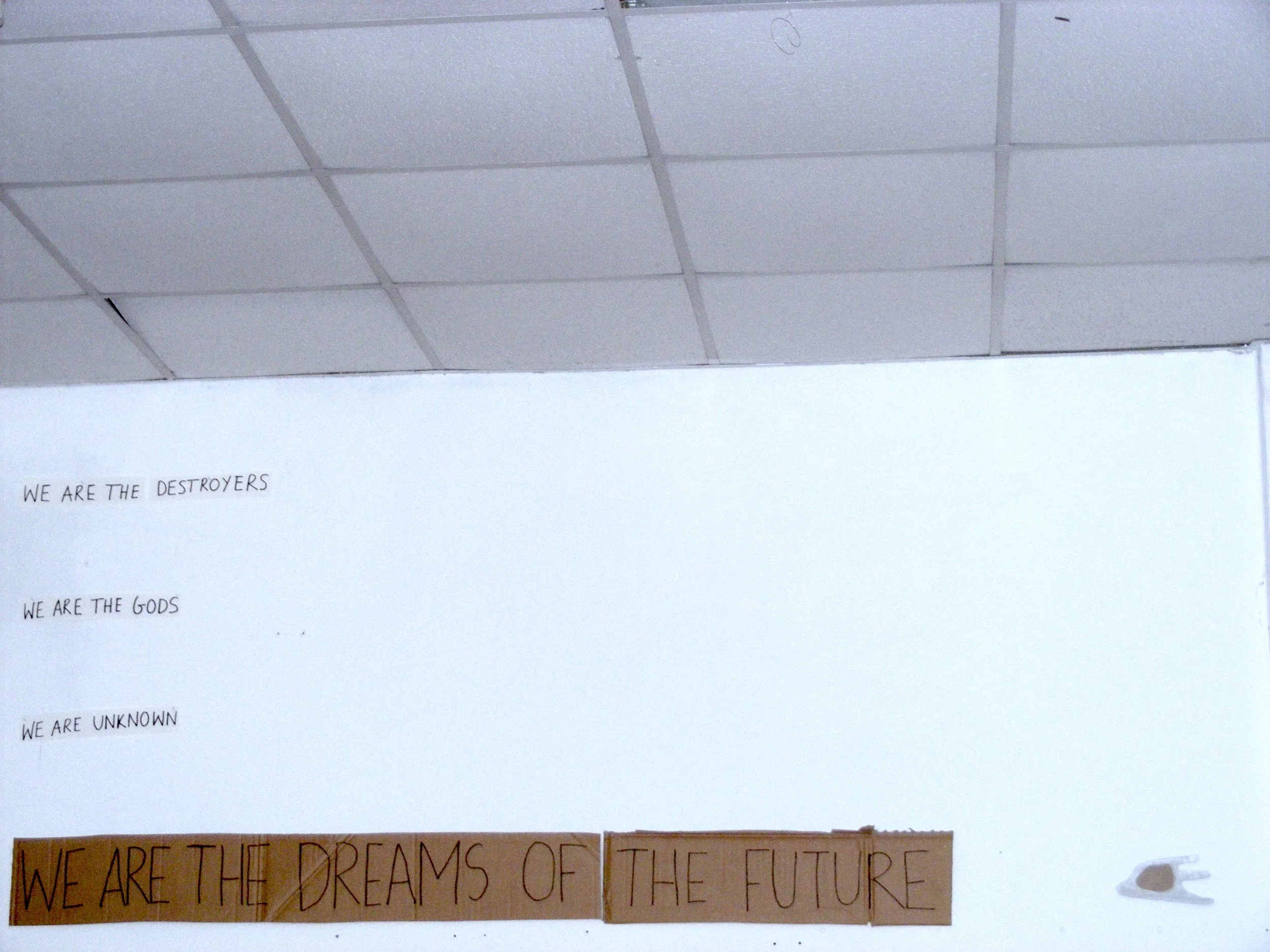
// Selected Paintings
Seems like
Acrylic paint on canvas
100cm x 170cm
2025
Written in Blue
Oil paint on canvas board
13cm x 9cm
2025
To be known
Oil paint on canvas board
23cm x 30cm
2025
Untitled (Blue is a vast world)
Oil paint on canvas board
60cm x 80cm
2024
We (Blue is a vast world)
Oil paint on canvas board
60cm x 80cm
2023


